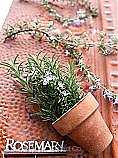By Paris Wolfe, Blogmaster, The Herb Society of America

Theo Bill, V.P., Sustainable Seed Co
Waiting for my big toe to heal from joint replacement, I spent a little (maybe, a lot) of time armchair gardening. That’s how I stumbled on the Sustainable Seed Company.
The family-owned company offers more than 1,875 varieties of organic and heirloom seeds, including 10 types of basil.I’m ordering the complete basil collection, but only a few of the 300 varieties of tomatoes.
I chose Sustainable Seed Company after quizzing Theo Bill, Vice President, about the meaning of “organic” seeds. It sounds responsible, but what does it really mean? In his words …
What is “organic” seed?
“Organic seed” technically means untreated or organic seeds that were planted, grown and harvested in an organically approved system. That means no GMOs, no overt pesticide or herbicide usage, and adherence to other National Organic Program rules. The “Spirit” of organic seed though is much broader – it covers the health of the soil, pollinators, water conservation, runoff issues, and more.
How is organic seed different?
Organic seed is grown in an organic method, so it becomes accustomed to organic growing
conditions. Conventional seed, for example, is often grown using a great deal of herbicides and pesticides. Organic plants don’t use the same kinds of chemicals and have to be hand-weeded or out-compete the weeds to thrive. They receive more natural fertilizer (often manures or natural minerals instead of anhydrous ammonia or other conventional fertilizer).
Unfortunately, more intensive manual labor and higher input costs, result in higher production costs. That means organic seed often costs more. However, you are buying a higher quality seed which is more weed-resistant and less reliant on herbicides and pesticides.
Why is organic seed better?
That depends on how you want to grow your plants, and what kind of inputs (including weeding) you’ll be using.
What are the most popular herb seeds sold by Sustainable Seed Co.?
Lavender would be our most popular followed by basil and rosemary.
What herb grows best from seed? What herb is the toughest to start from seed?
The easiest would be cilantro. The most difficult is probably rosemary.
What tips would you give for growing herbs from seed?
For Mediterranean herbs (rosemary, oregano, thyme, lavender, etc.) add clean sand to the soil mix for better drainage.
Thank you, Mr. Bill.
From Sustainable Seed Co. — Discovering “new” heirloom seeds is one of our passions, and we would love to hear from anyone who is growing heirloom seeds that have been passed down for generations. We hope to preserve this part of history and believe that, with the continuing encroachment from large producers of hybrid and GMO seeds, companies like ours, along with our customers, may be a crucial link to saving the future of food.





 By Paris Wolfe, Blogmaster, The Herb Society of America
By Paris Wolfe, Blogmaster, The Herb Society of America I am a thrift shopping junkie. And, it’s part of my gardening life.
I am a thrift shopping junkie. And, it’s part of my gardening life.  It’s not a novel idea. Just check out Adam Caplin’s “Planted Junk” from 2001. It’s one of several available garden junk books inspiring my summer fantasies.
It’s not a novel idea. Just check out Adam Caplin’s “Planted Junk” from 2001. It’s one of several available garden junk books inspiring my summer fantasies.  The chile pepper is hot.
The chile pepper is hot.
 Author Chris McLaughlin shows readers how to use botanicals to dye fiber and fabric in her book A Garden to Dye For (St. Lynn’s Press, 2014, $17.95). Her palette includes the obvious and the obscure. Indigo and madder root are well documented. But, did you know the properties of pokeberry, mint, bee balm, purple basil, marjoram, tansy? Check out Chris’s book and learn to coax color from nature.
Author Chris McLaughlin shows readers how to use botanicals to dye fiber and fabric in her book A Garden to Dye For (St. Lynn’s Press, 2014, $17.95). Her palette includes the obvious and the obscure. Indigo and madder root are well documented. But, did you know the properties of pokeberry, mint, bee balm, purple basil, marjoram, tansy? Check out Chris’s book and learn to coax color from nature.  How did you get interested in using plants for dye?
How did you get interested in using plants for dye?
 Tours of the estate gardens – 2.5 miles of manicured paths — may be more delightful for Herb Society members. Acres of formal and informal gardens were designed by America’s foremost landscape architect, Frederick Law Olmsted. From the beauty of the Italian Garden to the breathtaking trees in America’s first managed forest, Biltmore’s lush landscape is a living tribute to Olmsted’s genius.
Tours of the estate gardens – 2.5 miles of manicured paths — may be more delightful for Herb Society members. Acres of formal and informal gardens were designed by America’s foremost landscape architect, Frederick Law Olmsted. From the beauty of the Italian Garden to the breathtaking trees in America’s first managed forest, Biltmore’s lush landscape is a living tribute to Olmsted’s genius. Q. Is there a dedicated herb garden? Kitchen garden?
Q. Is there a dedicated herb garden? Kitchen garden?  I’ve swept away the last sugar cookie crumb and crushed cardboard packaging for recycling. My Christmas holidays are finished and a Valentine’s heart wreath adorns my front door. Now what?
I’ve swept away the last sugar cookie crumb and crushed cardboard packaging for recycling. My Christmas holidays are finished and a Valentine’s heart wreath adorns my front door. Now what?